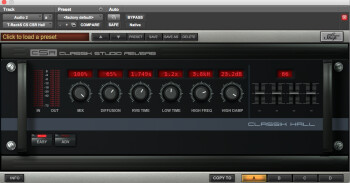Today we'll dive into reverb time, a most crucial parameter that needs to be handled cautiously.
Decay

Let’s start with the name. On your reverb plug-in, the reverb time might go under a unique moniker, like Time, Decay, Length, or even Decay Time. So, to be sure, check the manual.
Now let’s see what this parameter is all about. As its name implies, it determines the duration of the reverb. To be more precise, it’s the period of time during which you can hear the sound once the source signal feeding the reverb has disappeared. Far from being a subjective notion, this duration is determined by the RT60 specification, which is defined as the time it takes sound to drop 60dB in relation to the level of the original source.
But what good is this parameter when mixing? Contrary to what you might think, it doesn’t really give you any information about the size of the room. In fact, a small tiled room can have a reverb time that’s just as long as that of a huge concert hall! Decay is actually a representation of the materials within the room, like the surface of the walls (wood, tiles, concrete, etc.) and the floor (carpet, parquet, tiles, etc.). On the other hand, it also gives some hints about the shape of the room (rectangular, squared, circular, etc.).
That’s all really nice, but what does it all have to do with music, you ask? Well, this famous reverb time plays a crucial role in your capacity to perceive sound and, hence, adjust the reverb adequately. If the decay is too long, it might make the track you’re applying the reverb to seem overly wet. Conversely, too short a decay time will make itself evident by creating clearly audible gaps within the mix, which is not a very nice effect.
To adjust this parameter correctly, it’s useful to consider the tempo of the song, its density (whether the arrangement is very full or not too crowded), and its rhythmic content (whether its based on half-note or sixty-fourth-note patterns, for instance). A good rule of thumb is that if the track is fast and dense, the reverb time ought to be short. That said, personally, when it comes to the Decay, I tend to resort to a method that makes use of the custom metronome/pink noise trick I told you about some weeks ago. Making the metronome follow the groove of the track allows me to adjust the reverberation time so that the reverb does not interfere with the natural beat of the song; on the contrary, it actually breathes in time with it. You’re probably thinking this way of doing things is a too complex, but give it a try and then get back to me!
In the next episode we’ll tackle early reflections.


